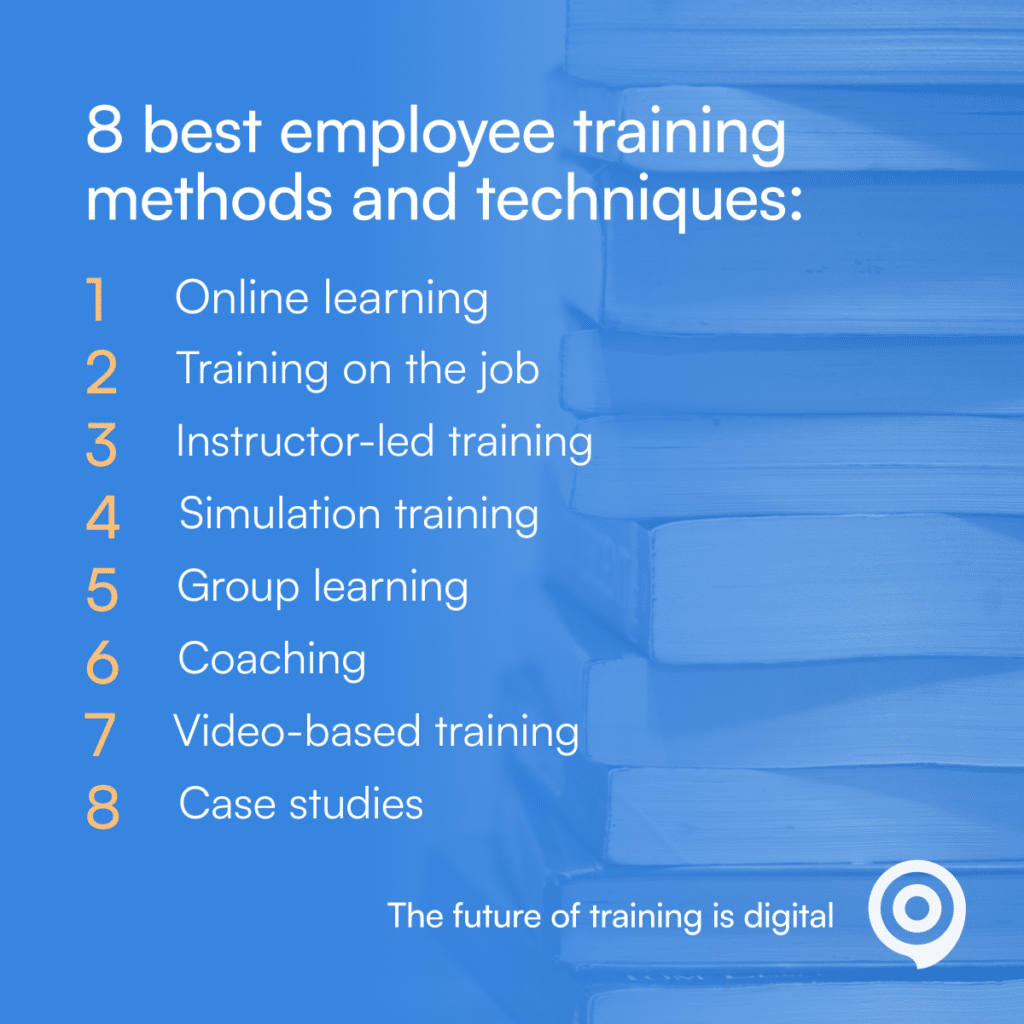Choosing the right training methods for employees
Effective employee training programs are an invaluable resource for organizations to ensure a competitive edge in their field of business. Often, most types of employee training mixes and matches various types of training methods. New employees might benefit more from hands-on training, while compliance training might be a reoccurring training module for all existing employees.
A mix-and-match approach to training can improve performance
When done correctly, organizational emphasis on and commitment to employee training can create an engaged and well-trained workforce that is motivated and highly productive, resulting in better overall performance for the business.
What are the most effective employee training methods?
Employee training is an important part of any successful business. Periodically training employees ensures that your staff has the skills they need to perform their job effectively, as well as providing them with the tools and knowledge necessary to succeed in their roles.
Some of the most popular employee training methods include:
- Online learning
- Training on the job
- Instructor-led training
- Simulation training
- Group learning
- Coaching
- Video-based training
- Case studies
The most effective employee training methods vary depending on the needs of the company but often involve a combination of both instructor-led and self-directed education. A well-rounded approach incorporating both traditional and modern training methods is often most beneficial for creating an engaged and productive workforce.

Why are employee training programs important?
An employee training program is essential for organizations to ensure their employees remain up-to-date with the changing technologies and trends in their industries. Proper training and career development programs also help to foster a corporate culture of innovation and continuous improvement, often esulting in increased motivation, productivity, and corporate loyalty.
Regularly conducted training also increases efficiency across the organization, since employees are equipped with the skills necessary to succeed in their roles. Additionally, offering career development programs can help attract top talent to your business by demonstrating that you are committed to developing your team’s skillset and investing in your human resources.
What is workflow learning?
Workflow learning is an innovative approach to employee training that integrates learning seamlessly into the daily workflow of employees. Instead of pulling employees out of their work environment for separate training sessions, workflow learning delivers bite-sized, relevant content at the moment of need. This method ensures that learning is directly applicable, immediate, and contextual. By embedding learning within the work process, employees can apply new knowledge and skills instantly, leading to improved performance and productivity.
1. Online learning
Online learning or eLearning is becoming an increasingly popular method of employee training. eLearning allows employers to deliver learning materials and content to their employees regardless of their physical location, making it an effective training option for remote teams. Online learning offers greater flexibility as well as improved tracking and evaluation of progress over traditional, classroom-based training methods.
Put the needs of your learners front and center
While eLearning has long been the preferred training method for corporate software training, it’s becoming more commonplace regardless of job function. Online training can readily be tailored to the specific needs of each individual employee, resulting in a better learning experience overall.
The needs and expectations of the learners should be at the heart of your online training strategy. Delivering successful online training requires an understanding of the format of the learning: it should be appropriate for the topic at hand and the target audience.
Use a multimedia approach
For instance, if the topic is complicated, a multimedia approach including videos, audio recordings, and interactive quizzes is more effective than relying on text alone. Software training, on the other hand, could benefit most from an interactive demo or a mock project, instead.
Provide feedback to learners
In order to deliver successful online training, instructors should provide frequent feedback to learners. This way, learners can better track their progress and validate their understanding of the training program and its goals. Online courses should also include engagement activities like virtual discussions, collaborative projects, or webinars.
Online learning is especially beneficial for remote teams. Discover best practices for onboarding remote employees to ensure a smooth integration into your organization.
2. Training on the job
As employee training methods go, on-the-job training is one of the most effective training methods for roles relying on practical skills. Training on the job helps employees succeed in their jobs early on, as the learning happens within the context of their work. Often, on-the-job training helps employers provide hands-on practice that reinforces topics covered in more formal training programs during onboarding.
Employees can achieve early success
On-the-job training gives employees the opportunity to develop problem solving, critical thinking, and technical skills which are essential for success in any role. This type of interactive training also allows employees to develop relationships with colleagues and gain a better understanding of their company culture.
Recommended for short onboarding time
Job shadowing, another form of on-the-job training, is an effective employee training method for more junior or new hires. Since employees observe experienced staff as they go about their normal duties, shadowing is especially beneficial for companies with high employee turnover rates or if new hires begin working immediately with a relatively short onboarding time.
By providing employees with the opportunity to shadow more experienced personnel, employers can ensure they understand all aspects of the job without interrupting business operations. Additionally, job shadowing is a great way to promote mutual respect between managers and subordinate staff members and demonstrate commitment and appreciation for their work.
Employees should feel comfortable asking questions
When delivering on-the-job training, employers should focus on creating an open environment that encourages employees to ask questions. Training should be tailored to the individual and should include both theory (lectures and online courses, for instance) and practical elements related to their roles. Additionally, managers should use real-time feedback to validate if employees are acquiring the desired skills. To ensure effective learning outcomes, employers should conduct frequent assessments to test employee knowledge and overall progress.

Do you want to save this for later?
Save this blog post as a PDF and read it when and where you want!
3. Instructor-led training
Instructor-led training is a typical employee training technique that mimics the physical classroom environment with the presence of the instructors leading the session. As traditional training methods go, it’s an especially effective way for employers to introduce topics, provide guidance, and assess areas of improvement in employee learning.
Ensure every participant is on the right track
By having a knowledgeable instructor present during training sessions, employees can benefit from the instructor’s experience and gain insights into how their job fits into the larger context of the organization. Instructor-led training also allows employers to practice real-time coaching with individual employees and ensure that all participants understand key concepts before moving on to more advanced material.
Create an environment for sharing ideas
Effective instructor-led training sessions involve careful planning and execution, with an emphasis on engaging the participants. Before each session, instructors should ensure they are familiar with the material and have a complete understanding of the desired learning objectives. During the session, facilitators should strive to create an environment where ideas can be shared and discussed openly.
Use case studies to maximize engagement
To maximize learning opportunities, instructors should focus on interactive training by including group work or case studies to keep the employees engaged.
Looking to enhance your skills in leading training sessions? Read our train-the-trainer guide for comprehensive insights.
4. Simulation training
Simulation training is a type of training method that utilizes interactive or immersive simulations to model realistic work scenarios. This type of computer-based training provides an engaging learning environment that allows employees to practice real-life situations in a controlled environment without any potential real-life risks.
Increases skill development while reducing errors
Simulation training helps employees develop their existing skills while also reducing the occurrence of errors due to lack of experience. As employee training techniques go, simulation training also reduces costs for employers as risky on-site training can be eliminated.
Roleplay to build confidence
Similar to simulation-based training, roleplaying is another highly effective training method that allows employees to practice and develop their skills in a realistic, yet safe, setting. Through roleplaying, employees can build their confidence and gain insight into different work scenarios, as well as develop their interpersonal communication and other soft skills. Employers, on the other hand, can identify potential issues and resolve them in a constructive way, while also ensuring that their employees are familiar with the company’s policies and procedures overall.
Simulate real-world situations
In order to deliver successful simulation training, the simulations should be designed to replicate real-world situations as accurately as possible. Instructors should provide meaningful feedback to ensure that learners are able to track their progress and make necessary improvements between sessions. Learners should also be given adequate time for self-study and practice in order to gain the most from the training.
Simulation training is particularly effective for complex systems like ERPs. Learn more about the importance of end-user training in ERP implementations and how it can lead to successful user adoption.
5. Group learning
Group learning provides employees with an opportunity to learn from each other in a collaborative environment. Through participation in group learning sessions, employees are able to develop better communication skills and understand different perspectives on the same problem.
Creates more engaged learners
Peer-to-peer training also encourages peer feedback, fostering critical thinking skills and creating a sense of responsibility among the team. As different training methods go, group learning often leads to more engaged learners as everyone is actively involved in solving the problem together. This type of employee training can also be used effectively to introduce new concepts or ideas to workplace training that may not have been discussed previously.
Facilitators focus on engagement and interaction
For group training to succeed, the learning and development professional facilitating the session should focus on creating an engaging and interactive environment for learners. Clear objectives and goals should be established in advance to ensure that everyone is on the same page regarding training outcomes. For best results, consider mixing activities (think including discussions, case studies, and role-playing scenarios in the training agenda) to keep employee motivation and engagement high.
6. Coaching
One-on-one coaching is an effective training method for employees as the primary focus is on exploring individual goals and objectives. Coaching helps employees gain insight into their behaviors and develop the skills necessary for professional success at their own pace.
Learning is encouraged in a safe space
Through the coaching process, employees can learn how to identify opportunities for professional development and create clear action plans that address their specific needs. Coaching also offers employees a safe space where mistakes are accepted and learning is encouraged. Training methods like coaching can also prove to be valuable during change management processes, helping staff stay motivated throughout mergers or layoffs.
Coach and learner should feel comfortable
For coaching to be effective, it should be delivered in an open and supportive environment where both the coach and learner feel comfortable. The coach should focus on the learner’s goals and objectives, while also being understanding of their unique needs and learning styles.
Establishing trust between the two parties is also essential in order to create a safe space for meaningful dialogue. Coaches should provide frequent feedback throughout the coaching process to help learners stay on track with their growth plans.
7. Video-based training
With video-based training methods, employees can learn at their own pace and review the material as often as needed.
Easy to understand and accessible
Compared to more traditional forms of training (think lectures and reading-based training methods), videos are often more engaging and easier to understand than written instructions. Thanks to the accessibility and convenience of video-based training, learners can participate in the training program virtually anywhere, at any time.
Make sure quality of visuals and audio is high for best effect
To get the most out of video-based training, the training process should be designed to be engaging and interactive, complete with visuals, animations, and demonstration videos. Both the audio and video quality should high enough so that learners can understand what is being presented. Often, video training is combined with group training or interactive online learning to keep learners actively engaged with the training material. In order to ensure the best learning outcome, instructors should also always offer follow-up support for any questions or clarifications about the video material afterward.
8. Case studies
Case studies are a powerful training tool for employees as they provide real-world examples of how to apply their skills and knowledge to business challenges. Case studies can also help employees identify potential risks associated with different decisions and recognize opportunities that can be taken advantage of.
Contextual examples of concepts
Often case studies are engaging, as they offer very contextual examples of different business and management theories and concepts at work. A case study-focused training session encourages problem-solving and can offer valuable feedback on the effectiveness of a company’s strategies and policies when looked at objectively.
Facilitators should relate case studies directly to the learning goals
Case study training should be designed to be both engaging and interactive. For best learning outcomes, is important for facilitators to provide guidance so that learners can apply their skills and knowledge accurately when discussing or solving a case. Facilitators also help relate the case studies back to the learning goals of the session overall.
By allowing employees to share their experiences with one another, case study training can also foster collaboration while strengthening employees’ understanding of both the training material and their own organization and existing business operations.
Interactive training methods
Interactive training methods engage learners actively, ensuring better retention and application of knowledge. These methods can include:
- Gamification: Incorporating game elements into training to make it more engaging and motivating.
- Interactive videos: Videos that include clickable elements, quizzes, and decision points.
- Virtual Reality (VR) and Augmented Reality (AR): Immersive technologies that place learners in a simulated environment or overlay digital information in the real world.
- Scenario-based learning: Real-world situations where learners make decisions and see consequences.
- Interactive simulations: Allows learners to practice tasks in a risk-free environment.
Create training that positively impacts organizational success
The success of an organization is impacted by how well employees are trained. The right training mix is the result of taking goals into account and then identifying knowledge gaps on the path to those goals. Then a training program needs to be developed to around the gaps in knowledge.
The most effective training programs are tailored to suit individual learning styles and job functions. In essence, training should be in multiple styles, from online to on-the-job, depeding on the role, the learning styles and the team structure.
Success story: Open Door – Next generation training for D365BC

Overview: Open Door, a leading Australian software solutions provider, faced the challenge of training their employees and customers on Dynamics 365 Business Central (D365BC) efficiently. With rapid system updates and a need to deliver ongoing support, traditional training methods were becoming increasingly ineffective.
Solution: Open Door implemented ClickLearn to create interactive, step-by-step guides, videos, and other learning materials for D365BC, significantly reducing training times and enhancing user engagement. The platform allowed Open Door to offer consistent and scalable training directly within the application, ensuring that employees and customers could learn on-demand and at their own pace.
Impact: By integrating ClickLearn, Open Door successfully reduced the complexity of onboarding new users to D365BC, improved user adoption, and cut down on training-related costs. The platform’s in-app guidance and contextual learning features provided users with immediate access to relevant training materials during their workflow, resulting in higher productivity and better system utilization.
Digital training is the way foward
Digital adoption platforms are powerful training tools that allow training providers to tailor learning, combining aspects of each method of learning. With a digital adoption platform, multi-media, scalable learning can be provided (at the click of a button) in learning styles to suit an individual’s tastes and needs. Digital adoption platforms that offer multi-language capabilities are ideal for large, multi-national organizations.
These platforms are prime for delivering different methods and styles of training to create a more easily scalable, multimedia experience that can be added into the existing training mix. Individual employees and orgainizations as whole benefit through increased productivity, decreased onboarding time, and reduction in training resources required.
A more engaging training program can be created combining the training methods (on-the-job, online, instructor-led, simulation, etc.) with the flexibility of a digital adoption platform. The result is a productive workforce.
With a digital adoption solution like ClickLearn, it’s possible to auto-produce training material, update and maintain training material with a minimal effort, deliver a full e-learning experience, and guide end-users within a company’s live system with a virtual assistant.
FAQ on training methods for employees
The most effective training methods for employees include on-the-job training, interactive e-learning solutions like ClickLearn, and blended learning that combines digital content with instructor-led sessions, all designed to provide hands-on, practical experience.
On-the-job training is the most commonly used method, as it allows employees to learn directly within their work environment, often with the help of digital tools and contextual guidance.
The three common methods are on-the-job training, e-learning or online courses, and instructor-led training, often enhanced with digital tools for better engagement and retention.







